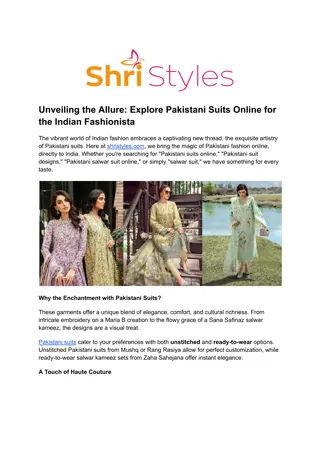Unveiling Misleading Practices in Data Presentation
Exploring the deceptive tactics employed in presenting data, this presentation sheds light on the types of misleading data, the risks associated with observational studies, manipulation of information from lab experiments to the media, and examples of misleading claims without valid data. It emphasizes the importance of cautious interpretation and transparency to prevent misinformation.
Download Presentation

Please find below an Image/Link to download the presentation.
The content on the website is provided AS IS for your information and personal use only. It may not be sold, licensed, or shared on other websites without obtaining consent from the author.If you encounter any issues during the download, it is possible that the publisher has removed the file from their server.
You are allowed to download the files provided on this website for personal or commercial use, subject to the condition that they are used lawfully. All files are the property of their respective owners.
The content on the website is provided AS IS for your information and personal use only. It may not be sold, licensed, or shared on other websites without obtaining consent from the author.
E N D
Presentation Transcript
THE NONSENSE DU JOUR Topic: Misleading with or without data Group 4: Yong Ming, Timothy, Bernetta Presenter: Bernetta
Outline Of presentation Types of misleading data Observational study Does the data exist? From lab bench to the glossies Case study: Antioxidants Conclusion
Types of misleading data Without data Essential data are not stated Not taken into account during the research With irrelevant data Any random science added just to add credibility Theoretical data from lab used
Observational study Context: olive oil offers measurable protection against skin wrinkling Variables: Wrinkles and food Confounders
Observational study and its data Need to be very cautious Observational study prone to confounders Extrapolated too far from the actual data Withholding crucial data Mislead people to make the wrong decisions
Does the data exist? Misleading with irrelevant data Example: pomegranates and wrinkles An article from Newsnight concluded that a recent study in American proves that eating pomegranates can protect us against aging There is no such study The authors actually knows the truth but only wants to impress us
From lab bench to the glossies Magazines often quote the results from lab research Searching thoroughly through the internet to find random bits of science Wants to add credibility to the article Need to be cautious about how to extrapolate from lab to real life complex system
From lab bench to the glossies Example: turmeric (curry) Protective against cancer Turmeric extract tipped on animal cells Can we conclude the results from this experiment? Very little curcumin is absorbed in our body Need to eat a few grams to reach a significant serum level Means that we need to eat 100g of turmeric
From lab bench to the glossies Context: drug companies Making claims on tenuous grounds Even though they are not allowed to talk to patients, they constantly annoy doctors to help them Use theoretical advantages, animal experiment data or surrogates outcome to add credibility to their product
From lab bench to the glossies Misleading with irrelevant data 1. Often weakly associated with real world issues (disease) 2. Developed in a very idealised world of an experimental animal 3. Does not show clear dose-response relationship 4. Kept under conditions of tight physiological control 5. Tissue and disease in animal model may be very different to living human system, even worst with a lab dish model 6. May be related to the disease in a different way
Cherry-Picking The idea is to try and give all the information to help others to judge the value of your contributions; not just the information that leads to judgement in one particular direction or another. ~Richard P. Feynman
Cherry-Picking Leads to misleading with irrelevant data Solution: systematic review Do an explicit research strategy to find data 1. Tabulate characteristic of each study 2. Measure the methodological quality 3. Compare alternatives 4. Give a critical, weighted summary Can save more lives than you could possibly imagine
Case-study: Antioxidant based on a research done in the past Helps to remove free radicals in our body Free radicals will damage DNA, leading to cancer Does eating more antioxidants prevent cancer?
Case-study: problems Free radicals are not always bad Does not necessarily make processes more efficient Results are not definite Why antioxidant seem to be good 20 years ago People are healthier back then and eat more fruits and vegetables which have a lot of antioxidants
Case-study: past experiment Studies showed a positive relationship between a lot of B-carotene and reduced risk of cancer 1. Case control studies: cancer free subjects have higher plasma carotene 2. Prospective cohort study: there is twice as much lung cancer in the group with lowest plasma carotene compared with those with the highest Shows that antioxidants are very good
Case-study: modern experiment 1. 18,000 participants recruited and randomised All at high risk of lung cancer Half received B-carotene, other half received placebo Results: people having antioxidant 46% more likely to die of cancer than those who took the placebo Terminated early due to ethical issues 2. Systematic research Assess quality of studies Results: antioxidants are either ineffective or actively harmful Results in more deaths instead
Case-study: conclusion Things that work in theory often do not necessarily work in practice Misleading with irrelevant data Should not be blindly following theoretical data and assuming that this must be automatically map into a dietary advice
Overall conclusion Misleading by withholding crucial data: Observational studies Misleading by irrelevant data: Quoting directly from theoretical lab data Cherry-picking Systematic processes THANK YOU THANK YOU























